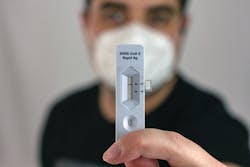Speed meets sensitivity to limit infectious spread in rapid microfluidic antigen testing
What’s the difference between microfluidic and lateral flow assays? Prior to the pandemic, these were esoteric terms typically confined to conversations within the four walls of the hospital laboratory; however, with the emergence of next generation point of care testing, it’s important to highlight the differences between these two technologies and what it means for SARS-CoV-2 antigen testing. In short, not all antigen assays are the same.
Lateral flow tests use passive capillary action to drive an immunochromatographic assay. Simply, in these tests, the liquid sample is absorbed throughout the nitrocellulose material, like a wick, and the reaction provides a result. Results are either read directly often by non-laboratory trained personnel with results determined by subjective observation (e.g., visually read rapid antigen flu tests), or more recently, in an effort to improve sensitivity, are coupled with a digital reader. These simple tests are cheap, portable, and provide results in about 5-15 minutes; however, notable limitations on sensitivity present challenges for SARS-CoV-2 testing. Requirements for higher concentrations of analyte to detect a positive signal constrain the sensitivity. They work well to rapidly identify infectious individuals with high viral loads, but performance is mitigated in individuals with relatively lower viral loads, but yet who may still be contagious. Hence, the proposed need for serial testing where sometimes, there will be negatives, but you’ll catch the positives if testing over the course of several days.
Microfluidic tests
Microfluidic tests integrate several technologies, which until now, have only been available in sophisticated, high complexity hospital laboratories. These novel systems actively manipulate microliter volumes with nanoliter levels of precision to deliver exceptional performance at the point of care. Reagent test strips interfaced with an analyzer through printed carbon electrodes and piezoelectric benders provide precise fluidic control to mix specimens. The microfluidic architecture can not only control mixing to accelerate reaction kinetics, but also control the analytical environment by washing away residual specimen. This enables liquid-free analysis to improve the resolution of the optical engine, enhancing the limit of detection (LoD) to ranges usually reserved for high-complexity instrumentation and test kits. These tests also precisely control reaction times and temperatures. Reaction times in microfluidic systems are much quicker than conventional devices due to the smaller dimensions of the systems, leading to a shorter diffusion time for any given molecule.1 Integrating these assets onto a single test strip provides the potential to revolutionize POCT by bringing the technology out of the conventional hospital laboratory and into the clinic, closer to the patient. This empowers uncompromised testing, where patients are seen, rather than sending a sample to be run elsewhere.
Microfluidic test strips are designed on similar principles as lab analyzer systems to deliver laboratory comparable performance across a number of parameters in a portable, easy to use, point of care solution. The SARS-CoV-2 Antigen tests are designed to detect the presence of nucleocapsid protein (N) at lower concentrations than what is typically feasible on POC lateral flow platforms. These high sensitivity, Rapid Microfluidic Immunoassays (RMI) have important implications in terms of how, where, and when a test can be used for pandemic control. We need rapid, accurate testing to fight COVID-19, because organizations, doctors, and individuals need to know if people are infectious, even when they are not symptomatic. But neither PCR nor conventional lateral flow antigen tests are optimized to meet those needs. The exceptional analytical sensitivity from RMI for SARS-CoV-2 nucleocapsid antigen is just right: it is fast and accurate, without being so sensitive it picks up remnant RNA from previously infected — but now recovered — non-infectious individuals.2 Recovered patients can continue to have SARS-CoV-2 RNA detected in their upper respiratory specimens for up to 12 weeks after symptom onset.2,3,4 Investigation of 285 “persistently positive” adults, which included 126 adults who had developed recurrent symptoms, found no secondary infections among 790 contacts to these case patients. Efforts to isolate replication-competent virus from 108 of these 285 case patients were unsuccessful.2
Winning the war against the pandemic will require extinguishing the wildfire of infectious spread. Tests that rapidly and accurately identify contagious spreaders, while being sufficiently inexpensive and easy to execute to allow frequent testing, can be a powerful tool for breaking the chain of transmission.5 PCR is the premier finder of nucleic acids, bar none. But molecular detection does not necessarily denote the presence of recoverable infectious virus. Recent data from a lab at Johns Hopkins suggests that antigen tests correlate better with viral culture, perhaps the best proxy for infectivity, than PCR.6 Recovering patients that are no longer infective can actively shed viral RNA at a level detected by PCR for weeks or possibly months.7 Detecting all viral shedders is an expensive luxury that does not necessarily serve society’s best interests.
Lateral flow antigen tests
Antigen-based testing, by contrast, could help to rapidly identify people who have high levels of virus — those who are most likely to be infectious to others — and isolate them from the community. However, not all antigen tests are the same. Lateral flow antigen (LFA) tests provide rapid results, but may not provide sufficient sensitivity to cover the full range of infectivity, which can be as long as 10 days. LFA tests are authorized for use in patients presenting within five to seven days post-symptom onset, depending upon the vendor. In a study published in the NEJM, viable virus was isolated from specimens collected up to nine days after the first evidence of typical symptoms;8 while in other studies, there is evidence that some individuals continue to spread the virus up to eight to ten days after showing symptoms.9 Serial testing algorithms compensate for sub-optimal sensitivity in an asymptomatic population, but negative results may provide a false sense of security to asymptomatic or presymptomatic individuals. In certain settings, this may lead to additional contacts, before the second test is performed 2-3 days later.
Conclusion
What society really needs is a point of care test sensitive enough to adequately cover the broadest range of contagiousness, provide results quickly, and at a reasonable cost, enabling widespread implementation across a variety of use-cases. Unlike lateral flow antigen tests, the emerging, next-generation microfluidic technologies simplify, scale down, and integrate techniques used in laboratory analyzers to provide lab-comparable diagnostic tests that can be easily used in community care settings. One system is authorized by FDA for emergency use during the COVID-19 pandemic for use on patients presenting up to 12-days post symptom onset, has superior sensitivity over most lateral flow assays, allows for the longest testing window currently available in waived settings, and shows a high positive predictive agreement (PPA) when compared to RT-PCR.10 The right test for this time catches the infectious of the COVID-19 pandemic, while minimizing false alarms.
References
- Convery N, Gadegaard N. 30 years of microfluidics. Micro and Nano Engineering. https://www.sciencedirect.com/science/article/pii/S2590007219300036. Published January 26, 2019. Accessed May 1, 2021.
- Interim gGuidance on dDuration of iIsolation and pPrecautions for aAdults with COVID-19. Centers for Disease Control and Prevention. https://www.cdc.gov/coronavirus/2019-ncov/hcp/duration-isolation.html. Published February 13, 2021. Accessed May 1, 2021.
- Li N, Wang X, Lv T. Prolonged SARS‐CoV‐2 RNA shedding: Not a rare phenomenon. Wiley Online Library. https://onlinelibrary.wiley.com/doi/10.1002/jmv.25952. Published May 22, 2020. Accessed May 1, 2021.
- Liu W-D, Chang S-Y, Wang J-T, et al. Prolonged virus shedding even after seroconversion in a patient with COVID-19. J Infect. 2020;81(2):318-356. doi:10.1016/j.jinf.2020.03.063
- Mina MJ, Parker R, Larremore DB. Rethinking Covid-19 tTest sSensitivity — A sStrategy for Ccontainment. N Engl J Med. 2020;383(22). doi:10.1056/nejmp2025631
- Pekosz A, Parvu V, Li M, et al. Antigen-based testing but not real-time polymerase chain reaction correlates with severe acute respiratory syndrome coronavirus 2 viral culture. Clin Infect Dis. January 2021. doi:10.1093/cid/ciaa1706
- Guglielmi G. Fast coronavirus tests: what they can and can’t do. Nature. 2020;585(7826):496-498. doi: 10.1038/d41586-020-02661-2. https://www.nature.com/articles/d41586-020-02661-2#ref-CR3. Published September 16, 2020. Accessed May 1, 2021.
- Arons MM, Hatfield KM, Reddy SC, et al. Presymptomatic SARS-CoV-2 infections and transmission in a skilled nursing facility. N Engl J Med. 2020;382(22):2081-2090. doi:10.1056/nejmoa2008457
- Walsh KA, Spillane S, Comber L, et al. The duration of infectiousness of individuals infected with SARS-CoV-2. J Infect. 2020;81(6):847-856. doi:10.1016/j.jinf.2020.10.009
- Drain PK, Ampajwala M, Chappel C, et al. A rapid, high-sensitivity SARS-CoV-2 nucleocapsid immunoassay to aid diagnosis of acute COVID-19 at the Ppoint of Ccare: A clinical performance study. Infect Dis Ther. February 2021. doi:10.1007/s40121-021-00413-x
About the Author

Richard H. Noel, MS
is the North American Marketing Director at LumiraDx.
